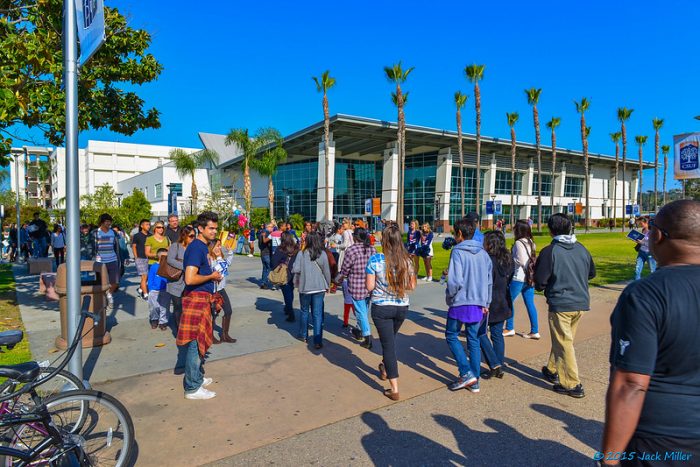
Cal State Student Newswire launched in March 2020 as a wire service for student publications in the California State University system. Over the last year, it’s evolved from a wire service to an experimental, collaborative initiative to produce journalism across all CSUs.
California State University is the largest public university system in the United States, with 23 campuses and more than 485,000 students. Its sprawling size has made any coordination of coverage among student papers difficult. For instance, the university chancellor might speak at one campus, but his remarks are relevant to several others. In the past, if multiple student publications in the CSU system covered the speech, there would have been no consistent way to track the stories, share them, or collaborate across campuses. At the same time, universities play major roles and impact the communities they’re based in, and student media often fills the gaps and breaks news where professional news outlets don’t have reporters.
Last year, Aidan McGloin was a senior at California Polytechnic State University – San Luis Obispo and a reporter for the campus newspaper, the Mustang News. Throughout his college journalism career, he’d found himself frustrated by issues that could be solved with more collaboration — like a lack of good photos of CSU board members or of sporting events. As a data reporter at the paper, he dug through CSU documents and found stories that could be relevant for the entire system, not just for his campus. He wanted to be able to share them with other student journalists.
So during last year’s Associated Collegiate Press Convention, McGloin rounded up a few student reporters and editors from other CSU publications and pitched them the idea of a wire service.
“I remember talking to a person who was [a campus media] advisor at a different CSU in my junior year, and I said that we should do something like this,'” McGloin said. “And she said, ‘Oh, you know, every couple of years for someone who wants to do that and then they end up graduating before they’re able to make it happen.'” But McGloin was determined.
The first member publications of the Cal State Journalism Newswire, which launched on March 1, 2020, were the Mustang News from Cal Poly San Luis Obispo; The Daily 49er from Long Beach State University; The Daily Aztec from San Diego State University; The State Hornet from Sacramento State University; The University Times from CSU, Los Angeles; The Runner from CSU, Bakersfield; and The Orion from CSU, Chico.
The wire is published for free on Substack. Editors at participating publications have the log-in information for the account. Whenever a publication publishes a story that might be relevant or interesting to other CSUs, they log in to Substack, format the story into a post, label it either for republication or for reference, and send it out.
Here’s how it worked in one instance: In April 2020, McGloin, as a fellow with the nonprofit California politics newsroom CalMatters, co-moderated a discussion with former CSU chancellor Timothy White about the pandemic through the CalMatters College Journalism Network, another initiative to share college journalism throughout the state.
McGloin sent out a request through the wire (via a post on Substack) asking other student journalists for their questions for White. What resulted were two stories, one from the State Hornet and one for CalMatters, for republication and available to all campus publications. McGloin said that when he reached out to White’s press contact, he was told that they had wanted to organize some kind of student media roundtable with the chancellor but hadn’t known how to go about it. Now there’s a way.
“We have a group chat, we have it running on Slack, and we have [the Substack],” McGloin said. “We work together in more ways than just sharing stories.”
Taylor Helmes, the editor-in-chief of the Cal State University, Dominguez Hill Bulletin, said the wire also serves as a way for student journalists to network with each other.
“It not only gives myself and reporters with the Bulletin more opportunities to get published and get their word out there and to just grow the audience, but we can also go to them for questions about finding sources, or about how they run their paper,” she said.
Being able to connect with other student journalists also fuels more journalism, Chris Ramirez, the editor-in-chief of the Golden Gate Xpress at San Francisco State University, said. His staffers are eager to work on multimedia projects. With access to the wire, they’re able to share their work and find sources. In an episode of a podcast called Gator Talk, host Sebastian Mino-Bucheli interviewed student journalists from other CSUs about the vaccine rollout as their campuses were being used to host mass vaccination sites.
For the Mustang News, reporter Omar Rashad wrote a story about how the Cal State Poly campus used more of its housing capacity than any other CSU campus. By compiling data from all 23 campuses, that story was then relevant to all of them. The story, and the data, were then made available for republication through the wire.
When the CSU chancellor held a virtual town hall in August 2020 and discussed pandemic protocols and anti-racism, the State Hornet published stories in both English and Spanish and made them available for republication.
“There’s a lot of stuff happening at the CSU-wide level, at the chancellor’s office. They are things that don’t necessarily take place at the local level but still affect everybody, and it’s hard really to keep an eye on all of that as it’s changing and shifting,” McGloin said. “This increases institutional knowledge, and I think that’s one of the reasons it’s really important.”